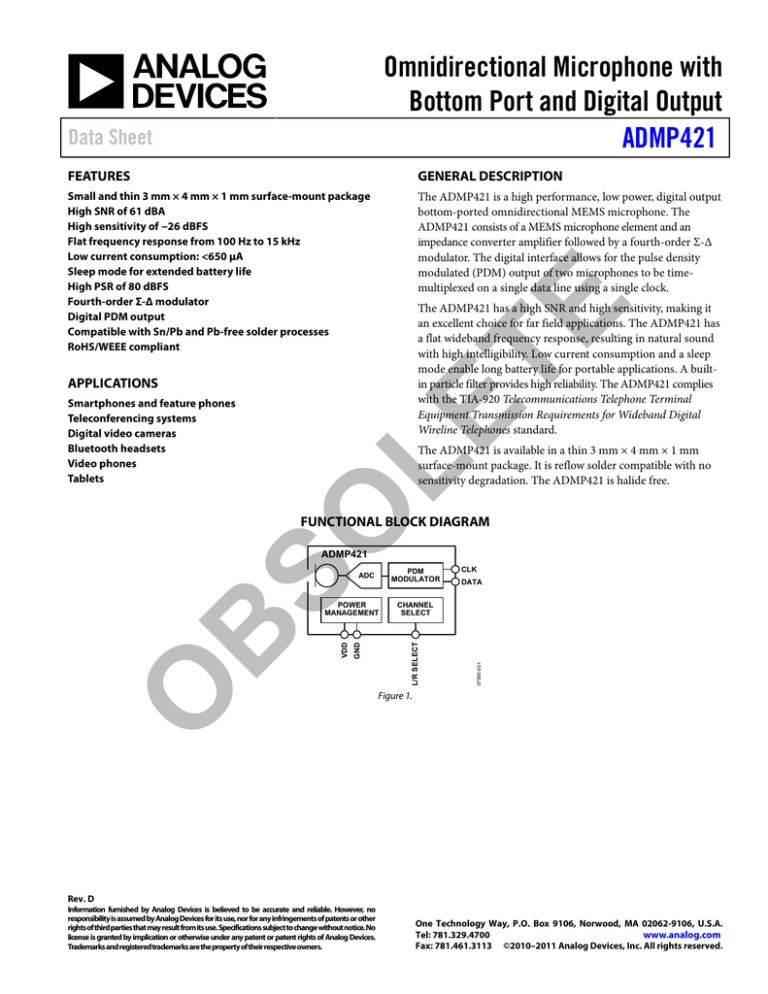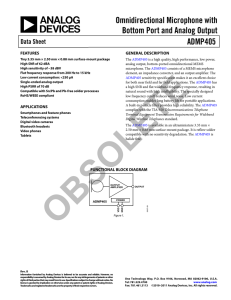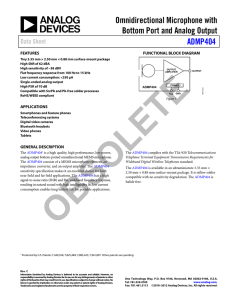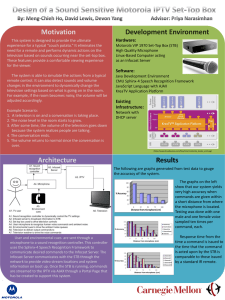Omnidirectional Microphone with Bottom Port and Digital Output ADMP421 Data Sheet
advertisement

Omnidirectional Microphone with Bottom Port and Digital Output ADMP421 Data Sheet GENERAL DESCRIPTION Small and thin 3 mm × 4 mm × 1 mm surface-mount package High SNR of 61 dBA High sensitivity of −26 dBFS Flat frequency response from 100 Hz to 15 kHz Low current consumption: <650 µA Sleep mode for extended battery life High PSR of 80 dBFS Fourth-order Σ-Δ modulator Digital PDM output Compatible with Sn/Pb and Pb-free solder processes RoHS/WEEE compliant The ADMP421 is a high performance, low power, digital output bottom-ported omnidirectional MEMS microphone. The ADMP421 consists of a MEMS microphone element and an impedance converter amplifier followed by a fourth-order Σ-Δ modulator. The digital interface allows for the pulse density modulated (PDM) output of two microphones to be timemultiplexed on a single data line using a single clock. TE FEATURES The ADMP421 has a high SNR and high sensitivity, making it an excellent choice for far field applications. The ADMP421 has a flat wideband frequency response, resulting in natural sound with high intelligibility. Low current consumption and a sleep mode enable long battery life for portable applications. A builtin particle filter provides high reliability. The ADMP421 complies with the TIA-920 Telecommunications Telephone Terminal Equipment Transmission Requirements for Wideband Digital Wireline Telephones standard. The ADMP421 is available in a thin 3 mm × 4 mm × 1 mm surface-mount package. It is reflow solder compatible with no sensitivity degradation. The ADMP421 is halide free. B SO Smartphones and feature phones Teleconferencing systems Digital video cameras Bluetooth headsets Video phones Tablets LE APPLICATIONS FUNCTIONAL BLOCK DIAGRAM ADMP421 PDM MODULATOR CLK DATA CHANNEL SELECT 07596-001 VDD O GND POWER MANAGEMENT L/R SELECT ADC Figure 1. Rev. D Information furnished by Analog Devices is believed to be accurate and reliable. However, no responsibility is assumed by Analog Devices for its use, nor for any infringements of patents or other rights of third parties that may result from its use. Specifications subject to change without notice. No license is granted by implication or otherwise under any patent or patent rights of Analog Devices. Trademarks and registered trademarks are the property of their respective owners. One Technology Way, P.O. Box 9106, Norwood, MA 02062-9106, U.S.A. Tel: 781.329.4700 www.analog.com Fax: 781.461.3113 ©2010–2011 Analog Devices, Inc. All rights reserved. ADMP421 Data Sheet TABLE OF CONTENTS Applications Information .............................................................. 10 Applications ....................................................................................... 1 Interfacing with Analog Devices Codecs ................................ 10 General Description ......................................................................... 1 Sleep Mode .................................................................................. 10 Functional Block Diagram .............................................................. 1 Revision History ............................................................................... 2 Power Savings When Disabling One Microphone in a Multimicrophone Application .................................................. 10 Specifications..................................................................................... 3 Supporting Documents ............................................................. 10 Timing Characteristics ................................................................ 4 Handling Instructions .................................................................... 11 Absolute Maximum Ratings ............................................................ 5 Pick-and-Place Equipment ....................................................... 11 ESD Caution .................................................................................. 5 Reflow Solder .............................................................................. 11 Pin Configuration and Function Descriptions ............................. 6 Board Wash ................................................................................. 11 Typical Performance Characteristics ............................................. 7 Reliability Specifications ................................................................ 12 PCB Land Pattern Layout ................................................................ 8 Outline Dimensions ....................................................................... 13 Alternate PCB Land Patterns ...................................................... 9 Ordering Guide .......................................................................... 13 LE REVISION HISTORY TE Features .............................................................................................. 1 6/11—Rev. A to Rev. B Changes to Figure 1 ...........................................................................1 Changes to Figure 5 ...........................................................................7 2/11—Rev. 0 to Rev. A Changes to Features Section, Applications Section, and General Description Section ............................................................1 Added Dynamic Range Parameter, Changes to Input Characteristics Parameter and Output Characteristics Parameter, Deleted Polarity Parameter, Table 1 ............................3 Changes to Table 3.............................................................................5 Changes to Table 5.............................................................................6 Added Power-Saving Features Section ...........................................8 Updated Outline Dimensions ....................................................... 13 Changes to Ordering Guide .......................................................... 13 B SO 11/11—Rev. C to Rev. D Changed PSRR to PSR ....................................................... Universal Changed Pb-Free Temperature from 245°C to 260°C, Table 4 .. 5 Changes to Figure 8 and Figure 9 ................................................... 8 Added Alternate PCB Land Patterns Section ............................... 9 Changes to Temperature Humidity Bias (THB) Description, Table 6 .............................................................................................. 12 4/10—Revision 0: Initial Version O 8/11—Rev. B to Rev. C Changes to Clock Frequency and Supply Voltage Parameters, Table 1 ................................................................................................ 3 Changes to Table 3 and Table 4 ....................................................... 5 Deleted Power-Saving Features Section ........................................ 8 Changes to Figure 9 .......................................................................... 8 Added Applications Information Section ..................................... 9 Added Supporting Documents, Evaluation Board User Guides, Circuit Note, and Application Notes Sections .............................. 9 Changes to Interfacing with Analog Devices Codecs Section ................................................................................................ 9 Moved Sleep Mode Section and Power Savings When Disabling One Microphone in a Multimicrophone Application Section ... 9 Changes to Figure 10 ........................................................................ 9 Change to Pick-and-Place Equipment Section ........................... 10 Deleted Evaluation Board Section ................................................ 10 Deleted Figure 10 and Figure 11; Renumbered Sequentially ... 10 Deleted Table 6; Renumbered Sequentially................................. 10 Deleted Figure 12 ............................................................................ 11 Change to Temperature Cycle Description, Table 6 .................. 11 Changes to Ordering Guide .......................................................... 12 Rev. D | Page 2 of 16 Data Sheet ADMP421 SPECIFICATIONS TA = 25°C, VDD = 1.8 V, CLK = 2.4 MHz, unless otherwise noted. All minimum and maximum specifications are guaranteed. Typical specifications are not guaranteed. Table 1. THD PSR CLK Min 1 kHz, 94 dB SPL 20 kHz bandwidth, A-weighted 20 kHz bandwidth, A-weighted Derived from EIN and maximum acoustic input Low frequency −3 dB point High frequency −3 dB point Deviation limits from flat response within pass band 105 dB SPL 217 Hz, 100 mV p-p square wave superimposed on VDD = 1.8 V Peak −29 Clock frequency of 2.4 MHz or less VIH VIL VOH VOL ILOAD = 0.5 mA ILOAD = 0.5 mA B SO Maximum Acoustic Input INPUT CHARACTERISTICS Clock Frequency Clock Duty Ratio Input Voltage High Input Voltage Low OUTPUT CHARACTERISTICS Output Voltage High Output Voltage Low Latency Wake-Up Time POWER SUPPLY Supply Voltage Supply Current SNR EIN Test Conditions/Comments Omni −26 61 33 87 100 15 −3/+2 Max Unit −23 dBFS dBA dBA SPL dB Hz kHz dB 3 1.0 40 0.65 × VDD 0.7 × VDD From sleep mode, power on VDD IS Typ TE Total Harmonic Distortion Power Supply Rejection Symbol LE Parameter PERFORMANCE Directionality Sensitivity 1 Signal-to-Noise Ratio Equivalent Input Noise Dynamic Range Frequency Response 2 Normal mode Sleep mode 4 1.8 80 % dBFS 120 dB SPL 2.4 3 3.3 60 0.35 × VDD VDD 0 <30 10 0.3 × VDD 3.3 650 50 MHz % V V V V µs ms V µA µA Relative to the rms level of a sine wave with positive amplitude equal to 100% 1s density and negative amplitude equal to 0% 1s density. See Figure 5 and Figure 6. 3 The microphone operates at any clock frequency between 1.0 MHz and 3.3 MHz. Some specifications may not be guaranteed at frequencies other than 2.4 MHz. 4 The microphone enters sleep mode when the clock is turned off or the clock frequency is less than 1 kHz. 1 O 2 Rev. D | Page 3 of 16 ADMP421 Data Sheet TIMING CHARACTERISTICS Table 2. Description Min Max Unit Input clock period 310 1000 ns DATA1 driven after falling clock edge DATA1 disabled after rising clock edge DATA2 driven after rising clock edge DATA2 disabled after falling clock edge 30 ns ns ns ns 20 30 20 Timing Diagram tCLKIN CLK t1OUTEN t1OUTDIS LE DATA1 TE Parameter Input tCLKIN Output t1OUTEN t1OUTDIS t2OUTEN t2OUTDIS DATA2 t2OUTEN O B SO Figure 2. Pulse Density Modulated Output Timing Rev. D | Page 4 of 16 07596-002 t2OUTDIS Data Sheet ADMP421 ABSOLUTE MAXIMUM RATINGS Stresses above those listed under Absolute Maximum Ratings may cause permanent damage to the device. This is a stress rating only; functional operation of the device at these or any other conditions above those indicated in the operational section of this specification is not implied. Exposure to absolute maximum rating conditions for extended periods may affect device reliability. Table 3. Temperature Range ESD CAUTION TSMAX TSMIN LE RAMP-UP TEMPERATURE CRITICAL ZONE TL TO TP tP TP TL TE Sound Pressure Level (SPL) Mechanical Shock Vibration Rating −0.3 V to 3.6 V −0.3 V to VDD + 0.3 V or 3.6 V, whichever is less 160 dB 10,000 g Per MIL-STD-883 Method 2007, Test Condition B −40°C to +85°C tL tS RAMP-DOWN PREHEAT B SO t25°C TO PEAK TIME 07596-003 Parameter Supply Voltage Digital Pin Input Voltage Figure 3. Recommended Soldering Profile Limits Table 4. Recommended Soldering Profile Limits O Profile Feature Average Ramp Rate (TL to TP) Preheat Minimum Temperature (TSMIN) Maximum Temperature (TSMAX) Time (TSMIN to TSMAX), tS Ramp-Up Rate (TSMAX to TL) Time Maintained Above Liquidous (tL) Liquidous Temperature (TL) Peak Temperature (TP) Time Within 5°C of Actual Peak Temperature (tP) Ramp-Down Rate Time 25°C (t25°C) to Peak Temperature Rev. D | Page 5 of 16 Sn63/Pb37 1.25°C/sec max Pb Free 1.25°C/sec max 100°C 150°C 60 sec to 75 sec 1.25°C/sec 45 sec to 75 sec 183°C 215°C +3°C/−3°C 20 sec to 30 sec 3°C/sec max 5 minute max 100°C 200°C 60 sec to 75 sec 1.25°C/sec ~50 sec 217°C 260°C +0°C/−5°C 20 sec to 30 sec 3°C/sec max 5 minute max ADMP421 Data Sheet PIN CONFIGURATION AND FUNCTION DESCRIPTIONS DATA 5 VDD 4 1 CLK 2 L/R SELECT 07596-007 3 GND Figure 4. Pin Configuration (Bottom View) Mnemonic CLK L/R SELECT 3 4 GND VDD 5 DATA Description Clock Input to Microphone. Left Channel or Right Channel Select. DATA1 (right): L/R SELECT tied to GND. DATA2 (left): L/R SELECT pulled to VDD. Ground. Power Supply. Placing a 0.1 µF (100 nF) ceramic type X7R capacitor between Pin 4 (VDD) and ground is strongly recommended for best performance and to avoid potential parasitic artifacts. The capacitor should be placed as close to Pin 4 as possible. Digital Output Signal (DATA1, DATA2). O B SO LE Pin No. 1 2 TE Table 5. Pin Function Descriptions Rev. D | Page 6 of 16 Data Sheet ADMP421 TYPICAL PERFORMANCE CHARACTERISTICS 10 –40 8 –50 6 4 –60 PSR (dBFS) (dB) 2 0 –2 –70 –80 –4 –6 –90 1k 10k FREQUENCY (Hz) –100 200 500 LE (dB) 1k FREQUENCY (Hz) 10k 07596-005 B SO –20 100 5k 10k Figure 7. Typical Power Supply Rejection vs. Frequency 10 –10 2k FREQUENCY (Hz) Figure 5. Frequency Response Mask 0 1k O Figure 6. Typical Frequency Response (Measured) Rev. D | Page 7 of 16 20k 07596-006 100 07596-004 –10 TE –8 ADMP421 Data Sheet PCB LAND PATTERN LAYOUT solder paste stencil pattern layout is shown in Figure 9. The diameter of the sound hole in the PCB should be larger than the diameter of the sound port of the microphone. A minimum diameter of 0.5 mm is recommended. The recommended PCB land pattern for the ADMP421 should be laid out to a 1:1 ratio to the solder pads on the microphone package, as shown in Figure 8. Care should be taken to avoid applying solder paste to the sound hole in the PCB. A suggested 3.80 ø1.70 CENTER LINE (0.30) 4× 0.40 × 0.60 TE 0.35 (1.000) 0.90 (0.30) 2.80 ø1.10 LE (0.30) (0.550) 2× R0.10 2.05 0.35 Figure 8. Suggested PCB Land Pattern Layout 2.45 B SO 1.498 × 0.248 0.9 0.248 × 0.948 (2×) 0.398 × 0.298 (4×) 1.849 0.35 1.45 CENTER LINE 1.000 1.525 1.849 24° 1.17 0.248 × 1.148 (2×) 0.375 24° 0.248 × 0.498 (2×) 1.498 0.205 WIDE 0.362 CUT (3×) Figure 9. Suggested Solder Paste Stencil Pattern Layout Rev. D | Page 8 of 16 07596-009 O 0.7 07596-008 0.70 (0.30) Data Sheet ADMP421 Note that in both of these patterns, the solid ring around the sound port is still present; this ring is needed to ground the microphone and for acoustic performance. The pad on the package connected to this ring is ground and still needs a solid electrical connection to the PCB ground. If a pattern like one of these two examples is used on a PCB, take care that the unconnected ring on the bottom of the ADMP421 is not placed directly over any exposed copper. This ring on the microphone is still at ground and any PCB traces routed underneath it need to be properly masked to avoid short circuits. O B SO LE Figure 10. Example PCB Land Pattern with No Enclosing Ring Figure 11. Example PCB Land Pattern with Broken Enclosing Ring TE 07596-011 The ADMP421’s standard PCB land pattern has a solid ring around the edge of the footprint, which may make routing the microphone signals more difficult in some board designs. This ring is used to improve the RF immunity performance of the ADMP421, but it is not necessary to have this full ring connected for electrical functionality. If a design can tolerate reduced RF immunity then this ring can either be broken or removed completely from the PCB footprint. Figure 10 shows an example land pattern with no enclosing ring around the edge of the part, and Figure 11 shows an example pattern with the ring broken on two sides so that the inner pads can be more easily routed on the PCB. 07596-012 ALTERNATE PCB LAND PATTERNS Rev. D | Page 9 of 16 ADMP421 Data Sheet APPLICATIONS INFORMATION INTERFACING WITH ANALOG DEVICES CODECS Analog Devices ADAU1361, ADAU1761, and ADAU1781 codecs feature digital microphone inputs that support the ADMP421 PDM output data format. See the connection diagrams shown in Figure 12, and refer to the AN-1003 Application Note and the codecs’ respective data sheets for more details on the digital microphone interface. SUPPORTING DOCUMENTS Evaluation Board User Guides UG-118, EVAL-ADMP421Z Bottom Port Digital Output MEMS Microphone Evaluation Board UG-183, EVAL-ADMP421Z-FLEX: Bottom-Ported Digital Output MEMS Microphone Evaluation Board The microphone enters sleep mode when the clock is turned off or the clock frequency falls below 1 kHz. In sleep mode, the microphone data output is in high impedance state and the current consumption is less than 50 µA. POWER SAVINGS WHEN DISABLING ONE MICROPHONE IN A MULTIMICROPHONE APPLICATION Circuit Note CN-0078, iMEMS Digital Microphone Simplifies the Interface to a SigmaDSP Audio Codec TE SLEEP MODE Application Notes AN-1003, Recommendations for Mounting and Connecting Analog Devices, Inc., Bottom-Ported MEMS Microphones AN-1068, Reflow Soldering of the MEMS Microphone AN-1112, Microphone Specifications Explained AN-1124, Recommendations for Sealing Analog Devices, Inc., Bottom-Port MEMS Microphones from Dust and Liquid Ingress LE The ADMP421 has a unique power-saving feature when used in systems where two or more microphones share the same clock and/or data lines. The microphone is designed to present high impedance on both the clock and data pins when the power supply (VDD) pin is at 0 V or floating. This disabled microphone presents no load to and consumes no power from other active microphones. B SO 1.8V TO 3.3V AVDD MICBIAS CLK ADMP421 VDD DATA 0.1µF O L/R SELECT ADAU1361 OR ADAU1761 GND BCLK/GPIO2 CLK ADMP421 VDD DATA JACKDET/MICIN 0.1µF GND DGND AGND 07596-010 L/R SELECT Figure 12. ADAU1361 and ADAU1761 Stereo Interface Block Diagram Rev. D | Page 10 of 16 Data Sheet ADMP421 HANDLING INSTRUCTIONS PICK-AND-PLACE EQUIPMENT REFLOW SOLDER The MEMS microphone can be handled using standard pickand-place and chip shooting equipment. Care should be taken to avoid damage to the MEMS microphone structure as follows: For best results, the soldering profile should be in accordance with the recommendations of the manufacturer of the solder paste used to attach the MEMS microphone to the PCB. It is recommended that the solder reflow profile not exceed the limit conditions specified in Figure 3 and Table 4. • • BOARD WASH When washing the PCB, ensure that water does not make contact with the microphone port. Blow-off procedures and ultrasonic cleaning must not be used. O B SO LE • Use a standard pickup tool to handle the microphone. Because the microphone hole is on the bottom of the package, the pickup tool can make contact with any part of the lid surface. Use care during pick-and-place to ensure that no high shock events above 10 kg are experienced because such events may cause damage to the microphone. Do not pick up the microphone with a vacuum tool that makes contact with the bottom side of the microphone. Do not pull air out of or blow air into the microphone port. Do not use excessive force to place the microphone on the PCB. TE • Rev. D | Page 11 of 16 ADMP421 Data Sheet RELIABILITY SPECIFICATIONS The microphone sensitivity after stress must deviate by no more than 3 dB from the initial value. Table 6. TE Description −40°C, 500 hours, powered +125°C, 500 hours, powered +85°C/85% relative humidity (RH), 500 hours, powered −40°C/+125°C, one cycle per hour, 1000 cycles +150°C, 500 hours −40°C, 500 hours All pins, 0.5 kV All pins, 1.5 kV All pins, 0.2 kV O B SO LE Stress Test Low Temperature Operating Life High Temperature Operating Life Temperature Humidity Bias (THB) Temperature Cycle High Temperature Storage Low Temperature Storage Component CDM ESD Component HBM ESD Component MM ESD Rev. D | Page 12 of 16 Data Sheet ADMP421 OUTLINE DIMENSIONS 4.10 4.00 3.90 0.95 REF 2.05 1.70 DIA. REFERENCE CORNER 3.54 REF 0.70 0.40 × 0.60 (Pins 1, 2, 4, 5) PIN 1 0.30 REF 1.10 DIA. 1.50 0.25 DIA. (THRU HOLE) 3 0.90 2.48 REF 1 2 5 4 0.30 REF 3.10 3.00 2.90 R 0.10 (2 ×) 2.80 1.05 REF TOP VIEW 0.35 0.35 1.10 1.00 0.90 0.30 REF 0.30 REF 0.72 REF 0.24 REF 06-16-2010-G SIDE VIEW TE 3.80 BOTTOM VIEW 8.00 4.001 3.20 1.60 MAX 1.50 NOM A B SO 12.30 12.00 11.70 2 3.80 1.50 MIN DIA O A DETAIL A NOTES: 1. 10 SPROCKET HOLE PITCH CUMULATIVE TOLERANCE ± 0.20. 2. POCKET POSITION RELATIVE TO SPROCKET HOLE MEASURED AS TRUE POSITION OF POCKET, NOT POCKET HOLE. 0.35 0.30 0.25 0.20 MAX 5.552 5.50 5.45 4.80 2.20 1.85 1.75 1.65 1.60 0.25 1.30 REF SECTION A-A 0.25 0.50 R DETAIL A 062408-A 2.05 2.00 1.95 LE Figure 13. 5-Terminal Chip Array Small Outline No Lead Cavity [LGA_CAV] 4 mm × 3 mm Body (CE-5-1) Dimensions shown in millimeters Figure 14. LGA_CAV Tape and Reel Outline Dimensions Dimensions shown in millimeters ORDERING GUIDE Model1 ADMP421BCEZ-RL ADMP421BCEZ-RL7 EVAL-ADMP421Z EVAL-ADMP421Z-FLEX 1 2 Temperature Range −40°C to +85°C −40°C to +85°C Package Description 5-Terminal LGA_CAV, 13” Tape and Reel 5-Terminal LGA_CAV, 7” Tape and Reel Evaluation Board Flex Evaluation Board Z = RoHS Compliant Part. This package option is halide free. Rev. D | Page 13 of 16 Package Option2 CE-5-1 CE-5-1 Ordering Quantity 5,000 1,000 ADMP421 Data Sheet O B SO LE TE NOTES Rev. D | Page 14 of 16 Data Sheet ADMP421 O B SO LE TE NOTES Rev. D | Page 15 of 16 ADMP421 Data Sheet O B SO LE TE NOTES ©2010–2011 Analog Devices, Inc. All rights reserved. Trademarks and registered trademarks are the property of their respective owners. D07596-0-11/11(D) Rev. D | Page 16 of 16





